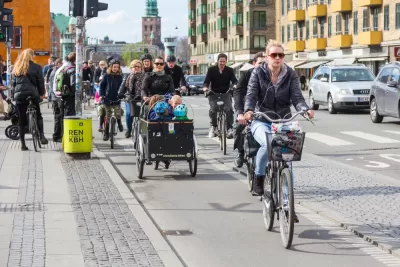Copenhagen's positive attributes are clear, but how transferable are they?

For years, American urbanists have visited Copenhagen and returned with what Macho Man Randy Savage once called "jealous eyes." The city’s thriving active transit community, density and overall civility are legendary. Martin C. Pedersen writes in Common Edge that there's good reason for the city's success: "It’s the product of a shared belief that transcends urban design, even though the city is a veritable laboratory for pretty much all of the best practices in the field."
While fewer than one percent of Americans bike to work, "Half of its residents commute to work on bikes (snow or shine), a large number even for Europe," Pedersen writes. Bike safety is taught to Copenhagen residents up through high school.
While American cities must move toward some of Copenhagen’s accomplishments to become more sustainable and equitable, Pedersen is realistic about how difficult it would be to "transfer" the city's success. One issue is that, as a city of 600,000, Copenhagen's challenges differ from a larger city's challenges. For instance, the city is getting richer and is, consequently, struggling to make room for lower income families. Tensions also simmer around the topic of immigrants. To export the city's strengths without its weaknesses is a tricky task.
FULL STORY: What We Can and Can't Learn from Copenhagen

Planetizen Federal Action Tracker
A weekly monitor of how Trump’s orders and actions are impacting planners and planning in America.

Chicago’s Ghost Rails
Just beneath the surface of the modern city lie the remnants of its expansive early 20th-century streetcar system.

San Antonio and Austin are Fusing Into one Massive Megaregion
The region spanning the two central Texas cities is growing fast, posing challenges for local infrastructure and water supplies.

Since Zion's Shuttles Went Electric “The Smog is Gone”
Visitors to Zion National Park can enjoy the canyon via the nation’s first fully electric park shuttle system.

Trump Distributing DOT Safety Funds at 1/10 Rate of Biden
Funds for Safe Streets and other transportation safety and equity programs are being held up by administrative reviews and conflicts with the Trump administration’s priorities.

German Cities Subsidize Taxis for Women Amid Wave of Violence
Free or low-cost taxi rides can help women navigate cities more safely, but critics say the programs don't address the root causes of violence against women.
Urban Design for Planners 1: Software Tools
This six-course series explores essential urban design concepts using open source software and equips planners with the tools they need to participate fully in the urban design process.
Planning for Universal Design
Learn the tools for implementing Universal Design in planning regulations.
planning NEXT
Appalachian Highlands Housing Partners
Mpact (founded as Rail~Volution)
City of Camden Redevelopment Agency
City of Astoria
City of Portland
City of Laramie




























